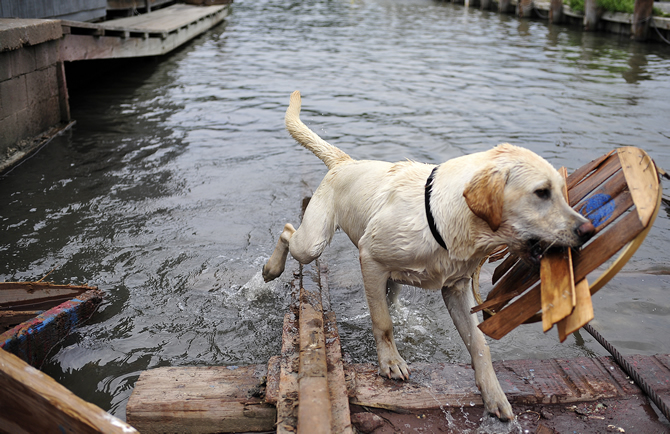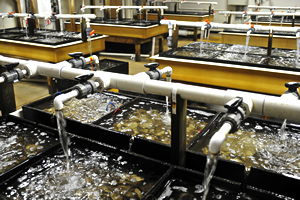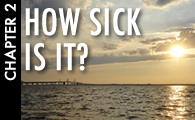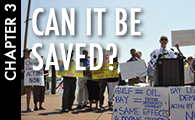
A yellow lab carries crab bucket lids at P T Hambleton Seafood in Bozman, Md. (photo by Jason Lenhart - News21)
Chapter 4: What of the Bay's Seafood and Watermen?

The oyster hatchery at the Horn Point Lab near Cambridge, Md.(Photo by Jason Lenhart - News21)
At the same time government agencies are fighting pollution, they are taking measures to restore the bay’s vastly depleted seafood populations. The Chesapeake blue crab may be staging a comeback, but the population of oysters, ravaged by disease, pollution and over-harvesting, is still down 99 percent from its heyday.
Maryland is making a major push to encourage oyster farming and preserve more natural habitat for bivalves. The state has proposed expanding areas deemed off limits to oystering, from nine to 25 percent of the quality habitat, in an effort to protect the future health of the famed Chesapeake oyster. It also is ramping up state-funded efforts to seed baby oysters, or “spat,” and encourage aquaculture, a type of fish farming already practiced successfully in other parts of the country.
Most of these efforts do not sit well with watermen who have freely fished the Chesapeake for generations. Many commercial crabbers and oyster-tongers who hang out by the wood-and-concrete docks in places like Tilghman Island are bitterly cynical about state-imposed harvesting restrictions, and they see state-created oyster sanctuaries as part of a state plan to run them out and transform the Chesapeake into a playground for the wealthy. On any given day, watermen on Tilghman will gather at the Dogwood marina, grab some beers from a cooler, pop them open and start to talk.
“I’ve had a piece of planting ground, of leased bottom, up that creek, my grandfather had it, went through from generation to generation. Now the state wants to take it if I don’t put over a million baby oysters on the ground a year,” storms Dennis Jones, still sitting in his pick-up truck.
Jones, 60, has a sunburned face, strong hands, and like the other three men standing around him, has spent his entire life on the water. Being forced out for him is not just about losing a job; it’s the end of his way of life. And he doesn’t have the money to fill a new state requirement that he seed his oyster ground or lose his right to fish there.
“They’re going to put us out of business,” he says. Jones, like other watermen, is convinced that the state – swayed by politics and special interests – wants eventually to sell leased bottom to larger businesses and squeeze the watermen out altogether.
There are not many watermen left--and even fewer young crabbers and oystermen. Near Tilghman Island, on the water in the small town of Bozman, is a family-owned seafood retailer called P.T. Hambleton’s that has been in business more than 60 years. The place is piled high with wooden crab buckets. Two friendly dogs, a Chesapeake Bay Retriever and golden Labrador, run up to visitors and plop down crab bucket lids, inviting them to throw them into the water for them.
“The future is not looking good for us,” says P.T. Hambleton IV, a 21-year-old waterman who started crabbing when he was 8. He is standing on the dock, camouflage jacket on under a slight rain. “I expect to see us as a younger generation as having to find new jobs later in life. I’m going to guess within the next 10 years.”
Farther south in Wake, Va., about an hour’s drive north of Norfolk, Doug McMinn and Irv Spurlock are the faces of aquaculture--a type of fish-farming that some see as the best hope for reviving commercial oystering in the Chesapeake. After eight years of experimenting and making mistakes, the two are now producing 2.5 million oysters a year, and they say the market is wide open.
“You still have some of your hard-core guys who think we are out of our minds,” said McMinn, a towering former math and science high school teacher who sniffs at those who say he is any less a waterman than those who focus on wild oysters.





